| | |
- "It's a fool's enterprise."
- ―Droma
Sabacc was a popular card game that was often played for high stakes. When played professionally, the game was overseen by a dealer, either organic, as in Coruscant's Outlander Club, where four-armed Kiughfid dealers passed out the cards and took up money for the house, or mechanical, as in other locales, where automated sabacc dealer droids oversaw proceedings. The Ryn claimed to have invented the sabacc deck and cards as a means of fortune telling.
Rules[]
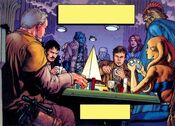
Sabacc could be played with Automated sabacc dealer droids.
The game of sabacc used a deck of seventy-six cards featuring sixty numbered cards divided into four suits, and two copies of eight special cards. Each player is dealt two cards (sometimes five, depending on the set of rules in play at the table) which make up their hand. There are four phases within each hand: Betting, Calling, Shifting and Drawing.
Betting phase: Beginning with the player to the left of the dealer, the player has the option to place a bet.
A typical game of sabacc is composed of several sequential rounds, and officially ends when a player wins with one of three special winning hands. At the beginning of each round, each player contributes an ante to the hand pot, which goes to the person with the winning hand at the conclusion of that hand. The winner in standard sabacc is the player who holds the hand with an absolute value closest to 23 (with both +23 and −23 being possible); this player wins the hand pot. Since −21 is closer to −23 than 20 is to 23, −21 would trump positive 20; however, in a situation where both −21 and 21 are in play at the same time, the positive 21 would triumph. Players with a hand above 23 or below −23 are considered to have Bombed Out, thus losing the hand, and in some cases, being forced to pay into the sabacc pot.
The sabacc pot is another pot to which players must ante each hand. This special pot can be won only by winning a hand with one of the three trump scores: a pure sabacc of either +23 or −23 (with the former trumping the latter) or an Idiot's Array. The Array is a special hand containing a card called The Idiot, worth zero, a Two of any suit, and a Three of the same suit. When laid out on the table, an Idiot's Array is read, literally, as 023, and is considered the highest hand in the game, trumping even a pure sabacc of 23. A win with any of those three special hands will give that player both the hand pot and the sabacc pot, and is typically seen as the end of gameplay for a single game.
Calling phase: A player has the option to call the hand during another player's calling phase but never his own.
Shifting phase: The cards themselves are small, electronic devices with a display panel covering the surface of one side; this panel is capable of shifting the displayed suit and value of each card when told to do so by the computer running the game, or when a player has the option to manually shuffle the card's value. In this fashion, a player can receive new cards of any possible suit or rank without actually having to take new cards from the deck itself.
Drawing phase: A player may also draw or discard individual cards from his hand. During the Drawing phase, a player may exchange a card in his hand for one in the deck. If the player decides to simply discard a card during this phase, that individual card is removed from play and is not subject to shifting.[3]
Strategy[]
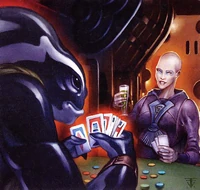
In sabacc, strategy is as much about the fact that other players may have better hands as it is about the fact that a player's hand might change when he least expects it. The values of the cards in play are shuffled at random and without warning; depending on the variant in play, this can even happen after a game has been called, but before the cards have been shown or tallied. Standard sabacc also includes the concept of locking the values of cards so that they do not change. When played at a professional table or venue, the table itself generates an interference field that players can push a face-down card into, and cards within this field are not subjected to randomization pulses sent by the game. Amateur or private games that do not utilize a professional table instead use cards that may be individually frozen by means of a special button on the card, or by placing a small interference chip over the card, simulating the field's effect. In some rule sets, however, the cards are randomized only when specifically chosen by the player, typically by pressing a spot on the card itself.
Tournament play[]
Tournament play includes several variations on the order of play, the dealing of cards, and the options available to players. Due to the higher stakes nature of the cash games in such tournaments, players traditionally have the option to do something known as folding out of play; essentially picking up their earnings and simply leaving. Of the five final players at the notable Cloud City Sabacc Tournament in 2BBY, two chose to fold, rather than bomb out. Additionally, at that tournament, players who had less than four cards were allowed to request an additional card during the rounds of betting. Han Solo used this option to receive a fourth card which, after the scrambling of all of his cards, gave him a score of twenty three, a pure sabacc.
House rules[]
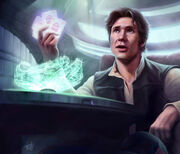
Han Solo playing a game of sabacc with the Millennium Falcon at stake.
Outside tournament play, most private games and professional establishments played sabacc using "house rules" or allowed players to specify one of the many rules variants that the table would use. House rules used a selection of modifications to the rules, for example often stating that a player could place at most two cards in the neutral field where they were unaffected by shifting, or that an Idiot's Array could be crafted using two different numerical suits, rather than requiring both the Two and Three be of the same suit. Another common house rule, as mentioned before, was that the bet amount was paid into the sabacc pot on bust, zero, or loss on call.
Variants[]
There were several common styles of sabacc play, including Bespin Standard, Empress Teta Preferred, Cloud City Casino, and Corellian Gambit. Each style had slightly different rules. Other variations included Jhabacc, which was a high-stakes version of sabacc[4]; Random sabacc, in which the house rules were changed at random intervals; Force sabacc, which used an altered deck with Light side of the Force and Dark side of the Force themed suits; Centran sabacc, which included extra cards and was often used in divination; and 1 seen in the Lucky Despot where the cards are printed on ceramic tiles. Two other variants were Rylothean rules and Dantooine rules.
The Galactic Empire as well as members of the Rebel Alliance often played a variant of Sabacc called "Trooper Sabacc" on various outposts to pass time between duty assignments.
The Gungans of Otoh Gunga developed a sabacc variant in which low scores prevailed.[5]
Baron Administrator Lando Calrissian was rumored to have won the position playing the Cloud City sabacc variant.[6]
Another variant was Riftwalker invented and played by asteroid miners in Chiloon Rift.[7]
A mathematical variant of sabacc was played by Ruurians and Givins at the The Thorny Toe cantina, in which players turned their cards into arithmetic operations. Han Solo won a hand with a 3√ (cubic root) of the cards the previous hand had dealt him[8].
Cheating[]
- "How many Corellians does it take to change a glowpanel? None! If the room's dark, you can't see Corellians cheating at sabacc!"
- ―Corran Horn
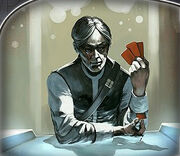
A sabacc cheater
As with any kind of gambling, the high-stakes nature of sabacc often led to cheating. Besides various basic sleight-of-hand palming tricks, many cheats used a cheater, a small handheld device that could be secretly used to manipulate the game cards and neutral field to give the user an unfair advantage in the game. Another means involved a skifter, a rigged card that was unobtrusively substituted for a normal one in the deck. Barpotomous Drebble once employed this against Lando Calrissian in a tournament, just before the latter won the deed to Cloud City on the planet Bespin. On some planets, cheating at sabacc could mean death or prison and a heavy fine. Force users who play sabacc may sometimes use the Force to stack the deck, or to view their opponents' cards.
Deck List[]
A standard sabacc deck includes 76 cards.
- Coins, Flasks, Sabers, Staves:
- 1–11
- Commander (12)
- Mistress (13)
- Master (14)
- Ace (15)
- Face Cards (two copies):
- Queen of Air and Darkness (−2)
- Endurance (−8)
- Balance (−11)
- Demise (−13)
- Moderation (−14)
- The Evil One (−15)
- The Star (−17)
- The Idiot (0)
In Centran sabacc, the deck only includes a single copy of the standard face cards listed above and possesses these additional face cards:
- The Destroyed Starship
- The Satellite
- The Wheel
- Chance
- Hazard
- The Universe
- Legate (a ranked card in each suit with a value of 11, but trumping the standard 11)
Other uses[]
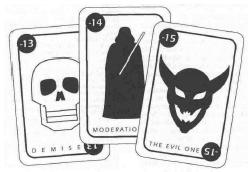
Sabacc cards.
- "Did you know, old pentapod, that these things were once used for telling fortunes?"
- ―Lando Calrissian to Vuffi Raa
The Centran sabacc deck was also used for divination and cartomancy. Lando Calrissian became familiar with using sabacc cards for fortune-telling early in his career. In a conversation with Vuffi Raa on the planet Sharu, Lando described the fortune-telling implications of several cards:
- The Commander of Staves implied "a messenger on a fool's errand" (a card Lando indicated that he frequently associated with himself).
- The Six of Sabres implied a journey's end.
- The Destroyed Starship implied "cataclysmic changes in the near future, death and destruction." Lando described it as "the worst card in the whole deck."
- The Satellite implied "a lot of fairly nasty things...deception, deceit, betrayal."
- The Wheel implied "luck, both good and bad, the beginning and the ending of things, random chance."
- The Universe implied that the subject would have the opportunity to do everything they wanted to do.
The order in which the cards were drawn suggested their meaning to the subject. The first card described the subject; the second the subject's principal opponent or antagonist. The third card drawn, placed above the others, represented the subject's conscious or stated motivations, while the fourth, placed below the others, represented a deeper, subconscious motive. The fifth card, placed to the left, represented the past; the sixth, placed to the right, represented the immediate future. Cards placed above it represented future obstacles. The final card drawn represented the final outcome.
It is unclear how widespread such use (or belief in its effectiveness) may have been.[10]
Behind the scenes[]
A complete deck and official rules were included in West End Games' RPG supplement Crisis on Cloud City. Michael Stern is credited, along with Douglas Kaufman and Greg Gorden, with developing these offical sabacc rules. Dice are used to simulate the shifting of card values.
Sabacc likely had its origins in the second draft of the script of the The Empire Strikes Back, when Han Solo mentions that his friend Lando Calrissian won Cloud City in a "sabacca game."[11]
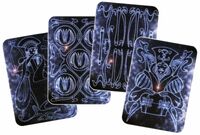
Naboo style sabacc cards
The Face Cards in the sabacc deck bear a definite resemblance to several of the Major Arcana cards in the Tarot deck, most likely a Rider-Waite deck, given that the value of The Idiot (The Fool) is 0, Endurance (Strength in the Rider-Waite deck) is 8, and Balance (Justice) is 11. Each face card's value seems to correspond with the number of its Major Arcana equivalent. In addition, the number of cards in a sabacc deck (76) is similar to that of a Tarot deck, which has 78 cards. The Centran sabacc deck, used in L. Neil Smith's Lando Calrissian novels (which contain the first named sabacc cards), is even more similar. Further parallels can be found in the use of sabacc cards for fortune-telling—which Lando Calrissian demonstrates in Lando Calrissian and the Mindharp of Sharu—just as some people use Tarot cards in real life.
In the Star Wars: Knights of the Old Republic duology, sabacc's predecessor, pazaak, makes an appearance, though it is not essential to play it in order to progress in either game.
Appearances[]
Non-canon appearances[]
- Tag & Bink: Revenge of the Clone Menace (Mentioned only)
Sources[]
Notes and references[]
- ↑ Darth Bane: Path of Destruction
- ↑ The New Jedi Order: Agents of Chaos I: Hero's Trial
- ↑ Crisis on Cloud City
- ↑ Star Wars: Complete Locations
- ↑ Clouds of Genarius: Head in the Clouds – Living Force
- ↑
 Star Wars Customizable Card Game — Cloud City Limited (Card: Cloud City Sabacc (Dark)) (backup link)
Star Wars Customizable Card Game — Cloud City Limited (Card: Cloud City Sabacc (Dark)) (backup link)
- ↑ Crucible
- ↑ New Jedi Order: Force Heretic III: Reunion.
- ↑ I, Jedi
- ↑ 10.0 10.1 Lando Calrissian and the Mindharp of Sharu
- ↑ Laurent Bouzereau, Star Wars: The Annotated Screenplays (New York: Del Rey, September 1997), p. 191 ISBN 0-345-40981-7


